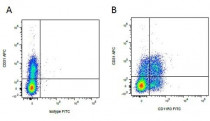ARG22952
anti-CD31 antibody [LCI-4] (APC)
anti-CD31 antibody [LCI-4] (APC) for Flow cytometry and Human,Pig
Cancer antibody; Cell Biology and Cellular Response antibody; Controls and Markers antibody; Developmental Biology antibody; Signaling Transduction antibody; Endothelial Cell Marker antibody; Microvascular Density Study antibody
Overview
| Product Description | APC-conjugated Mouse Monoclonal antibody [LCI-4] recognizes CD31 Mouse anti Pig CD31, clone LCI-4 recognizes porcine CD31, also known as Platelet endothelial cell adhesion molecule (PECAM-1). CD31 is constitutively expressed by platelets, monocytes and some lymphocytes, it is expressed by endothelial cells at a level, an order of magnitude greater that of other cell types (Fawcwett et al.1995). The extracellular region contains six Ig-like domains. Clone LCI-4 is cross reactive with human CD31 and binds to the 5th extracellular Ig domain, proximal to the transmambrane region as demonstrated by human CD31 domain deletion mutant protein binding studies (Nasu et al.1999). Mouse anti Pig CD31, clone LCI-4 immunoprecipitates a protein of ~130 kDa from lysates of porcine aortic endothelial cells and is strongly expressed at cell junctions (Nasu et al. 1999). |
|---|---|
| Tested Reactivity | Hu, Pig |
| Tested Application | FACS |
| Host | Mouse |
| Clonality | Monoclonal |
| Clone | LCI-4 |
| Isotype | IgG1 |
| Target Name | CD31 |
| Antigen Species | Pig |
| Immunogen | Porcine CD31/human IgGFc fusion protein. |
| Conjugation | APC |
| Alternate Names | EndoCAM; CD31/EndoCAM; PECAM-1; CD31; PECA1; CD antigen CD31; GPIIA'; endoCAM; Platelet endothelial cell adhesion molecule |
Application Instructions
| Application Suggestion |
|
||||
|---|---|---|---|---|---|
| Application Note | FACS: Use 10 µl of the suggested working dilution to label 10^6 cells or 100 µl whole blood. * The dilutions indicate recommended starting dilutions and the optimal dilutions or concentrations should be determined by the scientist. |
Properties
| Form | Liquid |
|---|---|
| Purification | Purification with Protein A. |
| Buffer | PBS, 0.09% Sodium azide, 1% BSA and 5% Sucrose |
| Preservative | 0.09% Sodium azide |
| Stabilizer | 1% BSA and 5% Sucrose |
| Storage Instruction | Aliquot and store in the dark at 2-8°C. Keep protected from prolonged exposure to light. Avoid repeated freeze/thaw cycles. Suggest spin the vial prior to opening. The antibody solution should be gently mixed before use. |
| Note | For laboratory research only, not for drug, diagnostic or other use. |
Bioinformation
| Database Links |
Swiss-port # P16284 Human Platelet endothelial cell adhesion molecule Swiss-port # Q95242 Pig Platelet endothelial cell adhesion molecule |
|---|---|
| Gene Symbol | PECAM1 |
| Gene Full Name | platelet/endothelial cell adhesion molecule 1 |
| Background | CD31 protein is found on the surface of platelets, monocytes, neutrophils, and some types of T-cells, and makes up a large portion of endothelial cell intercellular junctions. The encoded protein is a member of the immunoglobulin superfamily and is likely involved in leukocyte migration, angiogenesis, and integrin activation. [provided by RefSeq, May 2010] |
| Function | CD31 is a cell adhesion molecule which is required for leukocyte transendothelial migration (TEM) under most inflammatory conditions (PubMed:19342684, PubMed:17580308). Tyr-690 plays a critical role in TEM and is required for efficient trafficking of PECAM1 to and from the lateral border recycling compartment (LBRC) and is also essential for the LBRC membrane to be targeted around migrating leukocytes (PubMed:19342684). Trans-homophilic interaction may play a role in endothelial cell-cell adhesion via cell junctions (PubMed:27958302). Heterophilic interaction with CD177 plays a role in transendothelial migration of neutrophils (PubMed:17580308). Homophilic ligation of PECAM1 prevents macrophage-mediated phagocytosis of neighboring viable leukocytes by transmitting a detachment signal (PubMed:12110892). Promotes macrophage-mediated phagocytosis of apoptotic leukocytes by tethering them to the phagocytic cells; PECAM1-mediated detachment signal appears to be disabled in apoptotic leukocytes (PubMed:12110892). Modulates bradykinin receptor BDKRB2 activation (PubMed:18672896). Regulates bradykinin- and hyperosmotic shock-induced ERK1/2 activation in endothelial cells (PubMed:18672896). Induces susceptibility to atherosclerosis. Isoform Delta15: Does not protect against apoptosis. [UniProt] |
| Research Area | Cancer antibody; Cell Biology and Cellular Response antibody; Controls and Markers antibody; Developmental Biology antibody; Signaling Transduction antibody; Endothelial Cell Marker antibody; Microvascular Density Study antibody |
| Calculated MW | 83 kDa |
| PTM | Phosphorylated on Ser and Tyr residues after cellular activation. Phosphorylated on tyrosine residues by FER and FES in response to FCER1 activation (By similarity). In endothelial cells Fyn mediates mechanical-force (stretch or pull) induced tyrosine phosphorylation. Palmitoylation by ZDHHC21 is necessary for cell surface expression in endothelial cells and enrichment in membrane rafts. |
Images (1) Click the Picture to Zoom In
-
ARG22952 anti-CD31 antibody [LCI-4] (APC) FACS image
Flow Cytometry: Figure A. ARG22952 anti-CD31 antibody [LCI-4] (APC) and FITC conjugated mouse IgG1 isotype control. Figure B. ARG22952 anti-CD31 antibody [LCI-4] (APC) and FITC conjugated mouse anti porcine CD11R3. All experiments performed on red cell lysed porcine blood gated on mononuclear cells.






